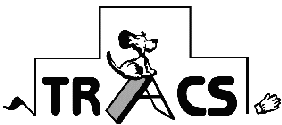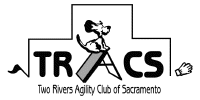SO YOU THINK YOU WANT TO LEARN TO TRACK YOUR DOG?
Members of the Two Rivers Agility Club of Sacramento (TRACS) participate in tracking training during the winter rainy season (essentially mid-November through the end of March). If you are curious to learn about what’s involved in training a dog to track, the following information should give you some preliminary understanding. If you’d like to actually observe this training activity, we’d love to have you come out to the fields or urban areas (for our Variable Surface Trackers) to see what we do.
For many, tracking is an addictive sport because hard work is most often rewarded with rapid results. Most people who have put a TD on a dog go on to put tracking titles on all of their dogs…and if they run out of dogs to title, some have been known to borrow dogs from friends or family members!
TRAINING:
We tend to do our training in groups, or by using the ‘buddy system’. The fields we use are in remote areas & it’s wise to have someone else there in case something goes wrong; we are, after all, hiking through fields that can have uneven footing, and accidents can happen. We do share those fields with the resident wildlife, so situations can arise in that regard as well. The ability to observe the other dog/handler teams also provides an invaluable learning opportunity. Laying tracks for others is a great way to sharpen your own track-laying skills, which will enable you to assist other tracking enthusiasts, and be entrusted with track laying responsibilities at Tracking events (for TRACS as well as other organizations).
You should realize that the winter months have shortened daylight hours. If you work full time and cannot flex your schedule, you can figure that you will be tracking in pre-dawn or post-dusk darkness, by headlights, flashlight or whatever it takes to get the job done initially. Or, you might choose to be a ‘weekend tracker’, and just enjoy a slower pace of progress. If you’re able to take your dog to work with you and do your tracking training during the day, some of us will be extremely envious, but we promise not to let it get the best of us. Thankfully, after the first 5 or so weeks of training, you & your dog should be sufficiently advanced to the point of having a more manageable training schedule, and the days will be starting to get longer, so training logistics do become a bit more relaxed.
You need to know that Tracking Tests are not cancelled due to rain, so we do train in inclement weather. You and your dog need to learn how to track in all weather conditions except lightning. It will at times be very cold, wet, and windy out in the field — you need to dress appropriately to be out in the elements. Quality rain gear can be quite costly but is a worthwhile investment for this sport, and the cost can be managed somewhat by shopping the sale racks. If you (or your dog) do not like Northern CA winter weather, you will not like tracking. Understand in advance that you, your dog, and your vehicle (inside and out) will get dirty. If the thought of this bothers you, you will not like tracking. Actually, most of us have found that with the rain and the early AM moisture in the fields our dogs need fewer baths during the tracking season than during the rest of the year (but muddy paws are muddy paws – enough said).
EQUIPMENT YOU WILL NEED:
- One healthy dog and a physically fit (or soon to be fit) handler – there’s a fair amount of hiking involved in this sport.
- A non-restrictive harness. Dog Show Specialties and PetsMart have them in nylon. If you’d prefer leather, you can order from J&J Dog Supplies.
- 45′ tracking line. You won’t need this for the first week or two (you’ll be starting your dog on a 6′ leash) and we suggest that you take a look at the lines that we use before you purchase yours. Most of us use climbing rope (available at REI) of different gauges depending on the size & strength of the dog.
- Rubber boots (for you) and waterproof rain gear.
- Paper, pencil, and clipboard – for drawing maps of your tracks.
- Tracking flags – two different colors, minimum of 5 each. (Flags come in bundles of 100; there are plenty of flags within the club – we can put you in touch with someone who’s got flags for sale in more reasonable quantities.)
- Enticing treats, and water for your dog.
- A copy of Glen Johnson’s Tracking Dog – theory & methods (paperback, out of print, but usually obtainable at the book vendor booths of larger dog shows or by shopping online at Amazon.com).
Tracking is truly a team sport and it is incredibly exciting to earn a Tracking title. As Tracking tests are scored simply as Pass or Fail, you will find that the camaraderie at Tracking tests is unlike that of any other dog event. A single Pass under one judge or team of judges earns your dog the title. All of the training is inducive; you cannot force your dog to track. Because the dog can work at his/her own pace, dogs of any age can learn to track. Tracking a puppy is a whole lot of fun; it builds confidence and it teaches the dog to problem solve. Similarly, tracking a senior dog provides an enjoyable activity for the two of you in those ‘sunset’ years. With dedication on your part, it is entirely possible to begin your tracking career and earn the TD (Tracking Dog) title within a single tracking season.
As you get drawn into this sport, you will find that you start looking at your surroundings differently. Your eye will be evaluating roadside fields for the possibility of doing some tracking there. Those of you who commute will find yourselves strategizing your drive home from work. You will reach a point in your training where you will be stopping off in a field on the way home from the office to lay a track so that it can be aging while you continue on home to get your dog & come back. You ladies won’t care that you may appear foolish in a skirt & rubber boots out in the field planting flags. You will think you’ve got a real shot at losing some weight with all the hiking you’re doing with your dog & your fellow trackers . . . but, since there’s only time & energy for “fast food”, you will most likely negate the benefits of all that hiking & you won’t lose an ounce. If this is the case, you can rationalize that
muscle weighs more than fat, and you will most certainly be gaining some leg muscle during the tracking season.
So, now that you’ve read this, if you still think you want to learn to track your dog, talk to us! Email the Tracking Coordinator. We would be happy to hook you up with active trackers in our club!
Bonus Material!
This matrix summarizes the tracking titles and the requirements for each title.
Good write up on TICKS.
Good write up on SNAKEBITES.

